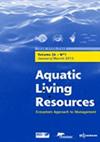The history of the European native oyster Ostrea edulis in Northern Irish waters and the four phases of resource exploitation
IF 1.9
4区 农林科学
Q3 FISHERIES
引用次数: 0
Abstract
An in-depth history of the European native oyster in Northern Irish waters has been absent from international and regional peer-reviewed publications. The knowledge of historical losses and a need to recover ecosystems for habitat and biodiversity purposes are primary drivers in an urgency to restore Ostrea edulis. However, a comprehensive record of O. edulis in Northern Ireland is required to assist with this work. The authors compiled a list of relevant references from grey material, rare historical archives, library collections, government reports and peer-reviewed publications. Archival reviews have been tabulated into a timeline, which documents site location, exploitation, sites of significant interest and socio-economic histories of the coastal communities who relied on the oyster. The reference material identified four distinctive phases of exploitation whereby harvesting transits from personal use to commercialization, collapse and then restoration. The study revealed that O. edulis harvests in the early 1800s in Northern Ireland were predominantly destined for export to supply collapsing stocks throughout Britain. Fishing was intense with the fishery closed by 1903. However, the species has proved to be extremely resilient with small artisanal fisheries still in existence today. This research will offer habitat managers guidance in relation to site selection and anthropogenic pressures when restoring the European flat oyster to the iconic historical beds of the Northern Irish Sea loughs.
北爱尔兰水域欧洲原生牡蛎的历史及资源开发的四个阶段
在国际和地区同行评议的出版物中,没有关于北爱尔兰水域欧洲本地牡蛎的深入历史。对历史损失的认识,以及为栖息地和生物多样性目的恢复生态系统的需要,是迫切恢复毛竹的主要驱动因素。然而,为了协助这项工作,需要在北爱尔兰有一份全面的edulis记录。作者从灰色材料、罕见的历史档案、图书馆收藏、政府报告和同行评审的出版物中编制了一份相关参考文献清单。档案审查已编制成时间表,其中记录了地点,开发,重要利益的地点和依赖牡蛎的沿海社区的社会经济历史。参考材料确定了四个不同的开发阶段,即收获从个人使用过渡到商业化,崩溃,然后恢复。研究表明,19世纪初北爱尔兰的毛豆收成主要用于出口,以供应英国各地濒临崩溃的库存。由于渔业在1903年关闭,捕鱼活动非常激烈。然而,该物种已被证明具有极强的适应力,今天仍然存在小型手工渔业。这项研究将为生境管理者提供有关地点选择和人为压力的指导,当将欧洲平牡蛎恢复到北爱尔兰海湖泊的标志性历史床时。
本文章由计算机程序翻译,如有差异,请以英文原文为准。
求助全文
约1分钟内获得全文
求助全文
来源期刊

Aquatic Living Resources
农林科学-海洋与淡水生物学
CiteScore
2.30
自引率
0.00%
发文量
10
审稿时长
>24 weeks
期刊介绍:
Aquatic Living Resources publishes original research papers, review articles and propective notes dealing with all exploited (i.e. fished or farmed) living resources in marine, brackish and freshwater environments.
Priority is given to ecosystem-based approaches to the study of fishery and aquaculture social-ecological systems, including biological, ecological, economic and social dimensions.
Research on the development of interdisciplinary methods and tools which can usefully support the design, implementation and evaluation of alternative management strategies for fisheries and/or aquaculture systems at different scales is particularly welcome by the journal. This includes the exploration of scenarios and strategies for the conservation of aquatic biodiversity and research relating to the development of integrated assessment approaches aimed at ensuring sustainable and high quality uses of aquatic living resources.
 求助内容:
求助内容: 应助结果提醒方式:
应助结果提醒方式:


